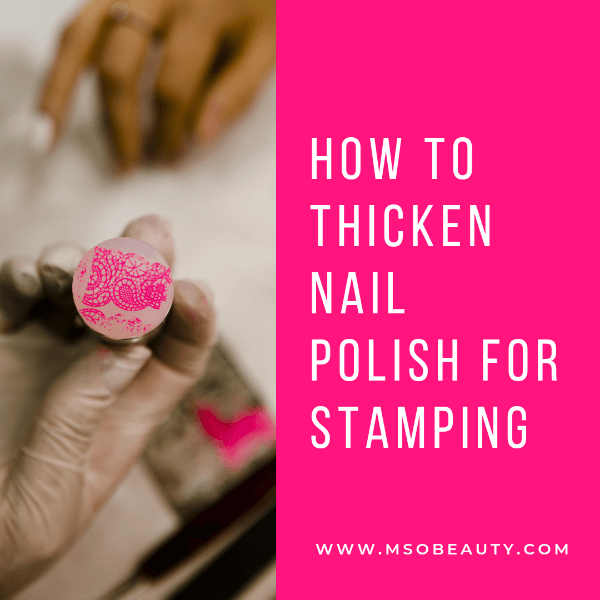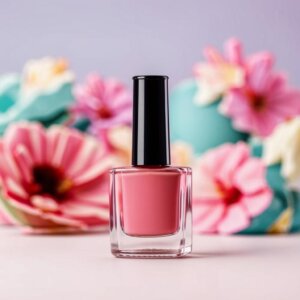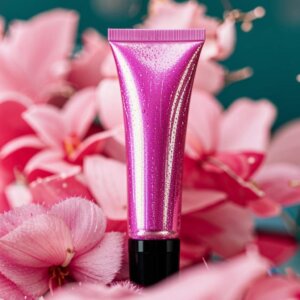Would you like to learn how to thicken nail polish for stamping or just how to make thin nail polish thicker? What can you use as a nail polish thickener? Read on!
The popular stamping nail technique can produce gorgeous results on your nails. Stamping requires the use of special thick nail polishes that you’ll need to apply to stamping pads and transfer to your nails using a nail stamper.
How to thicken nail polish for stamping?

Most nail polishes and gel nail polishes are unusable for stamping because they are too thin and runny and you can’t transfer them easily.
But what if you’ve run out of stamping polishes or can’t find the color you want? How to thicken the nail polish of your choice to use it for stamping? How to make thin nail polish thicker?
Here is a no-nonsense guide!
Why should the stamping polish be thicker than regular polish?
Stamping polish needs to be thick because it stays on the stamping plate better, fills the etched ornament, and doesn’t run away.
It also sticks to the nail stamper very well. So you can transfer it to your nail plate without losing elements of the stamped ornament in the process.
Why are nail polishes less thick than stamping nail polishes?
Nail polishes are less thick than stamping nail polishes because they contain solving agents in their formula.
This is necessary for you to be able to spread the polish easily all over the nail plate for coating your nails with a thin and even layer of the product.
How to make thin nail polish thicker for stamping step by step?
Open the bottle
The easiest way to thicken nail polish for stamping is to open the nail polish bottle and leave it to stand for some time.
Some of the solving agents inside it will evaporate and the polish will become thicker.
To make this method more effective leave the open bottle in a warm and well-ventilated place. For example, next to an open window.
Fresh and warm air will make it thicken faster.
You can even use a fan to increase the airflow to the polish and make it thicken faster.
Make sure the bottle stays in a safe place where it can’t be knocked over.
You can place the bottle in an open container or a drinking glass.
That way the air will still reach inside the polish bottle but you’ll have the polish contained in case it spills.
Caution! Never place your nail polish next to a heat source. Nail polish is very flammable.
Remove the brush
However, you wouldn’t want the polish on the bottle’s brush to become thick as well.
This will ruin the brush and make it unusable.
So when you open the bottle and are about to leave the polish for thickening remove the cap with the brush and clean the brush with a lint-free wipe.
After that, you can pour a bit of nail polish remover into a bowl for soaking the polish off the brush.
To make the brush extra-clean wash it with water and dry it with a lint-free wipe thoroughly.
Don’t place the cap with the brush back into the bottle while the polish stays open for thickening.
To prevent the brush from gathering dust and debris while you’re keeping it outside the polish bottle wrap the brush in a piece of plastic shrink wrap.
Check the consistency of your polish
The open-bottle air-drying method of nail polish thickening is pretty slow.
It can take days to thicken nail polish for stamping like that.
So you shouldn’t forget about your polish or it will become solid.
You’ll need to check it from time to time and close the bottle when you get the consistency you would like for stamping.
Just like you do when baking muffins, you can perform the toothpick test to check whether the polish is thick enough to use for stamping.
Submerge the toothpick into the polish and check its flow.
How to thicken nail polish for stamping with Xanthan Gum?
There is another method of how to make thin nail polish thicker that is gaining popularity on social media.
You can also thicken the polish your want to use for stamping with the help of adding Xanthan Gum to it.
This is a much quicker method that’s why it’s so popular online.
Xanthan Gum is a thickener that is often used in the food industry and cosmetics. For example, in jams, sauces, and lip glosses. It’s a lot like gelatine.
Bakers also add it to gluten-free dough to increase its elasticity.
Xanthan Gum a polysaccharide, which means a string of multiple sugars, that comes in form of a thick gel.
It makes any liquid you add it to more viscous.
The European Food Safety Authority has stated that Xanthan Gum is safe to use as a food additive.
So it’s safe to use to thicken nail polish for stamping.
Its manufacturing process only involves fermentation using bacteria.
This ingredient is also vegan and cruelty-free.
How to use Xanthan Gum to thicken nail polish for stamping?
Try to get transparent or clear Xanthan Gum. Even better if you get cosmetic-grade Xanthan Gum for DIY beauty products.
COCOJOJO Cosmetic-Grade Xanthan Gum Powder
This product should be as clear as gelatine.
This is very important!
If you use regular Xanthan Gum as a nail polish thickener it may make your polish milky or even change its color.
First, try adding just a little bit of the thickener to the polish.
If it’s not thick enough you can always add more.
But if it gets too thick there’s not much you can do.
That’s why you should add it little by little and mix it in very well.
You can perform the toothpick test to check the consistency of your thickened polish.
Stop when you see that it’s thick enough for stamping.
The downside of this nail polish thickener is that the polish can still change its color slightly because Xanthan Gum may add a bit of yellow to the mix.
After all, real stamping polishes don’t contain Xanthan Gum.
How to thin the thickened nail polish back?
If you have thinned the polish with the open bottle method you can bring your nail polish back into its natural thinner state by adding a nail polish thinner or acetone to it.
However, it may not work as well as you’d like.
That’s why I don’t recommend thickening regular polish for stamping.
You can ruin your polish.
There are tons of great special polishes for stamping on the market and you can find one for every design imaginable.
Recommended reading:
Best Professional Gel Nail Polish Brands Used In Salons
Non-Toxic Gel Nail Polish Brands 101: Choose The Safest Gel Nail Polish
Overlay Nails 101: Acrylic And Gel Nail Overlay On Natural Nails – The Ultimate Guide
Why Are My Gel Nails Lifting? 15 Reasons Why Your Gel Polish Is Lifting
Best No Light Gel Polish — Gel Nail Polish Without UV Light
Most Popular Shellac Colors – The Ultimate List Of 15 Best Shellac Colors For Fantastic Manicures
13 Best Korean Night Cream Products That Are Popular For A Reason
Best Gel Base And Top Coat: The Updated List Of The Best Gel Nail Base And Top Coat Sets
Best Small Salon Reception Desk For A Tight Space: Make An Amazing First Impression!
Nail File Grit Guide And Chart
13 Best Korean Snail Serum Products That May Seem Too Good To Be True
Best Nail Dehydrator And Primer: The Ultimate Guide
12 Best Polygel Nail Kit Reviews And How To Apply Polygel At Home
10 Best UV and LED Nail Lamp Units For Gorgeous Gel Nails
7 Best Korean Peel-Off Mask Products For Improving Skin Texture
How To Shape Almond Nails — The No Nonsense Guide
11 Best Nail Files For Natural Nails That’ll Make Nail Shaping Easier
Nail Shapes Chart And Types Of Nail Shapes 2021 — The Ultimate Guide
10 Best Korean Cleansing Balm Products That’ll Probably Be Your New Skincare Secret
15 Best Korean Foam Cleanser Products For All Skin Types
7 Best Magnets For Nail Polish To Help You Create Stunning Cat-Eye Nails
10 Best Nail Polish Pens And Pen Sets To Make Easy Nail Art At Home
14 Best Nude Gel Nail Polish Colors For Every Skin Tone
How To Remove Gel Nail Polish From Acrylic Nails Without Ruining Them: 2 Proven Ways
How To Thicken Nail Polish For Stamping Easily?
Do I Need A Base Coat For Gel Nails? Here’s The Answer!
Do You Need A UV Lamp For Acrylic Nails?






